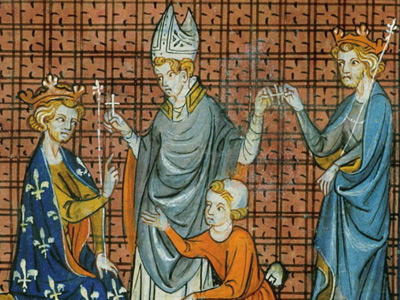Third Crusade (1189–1192)
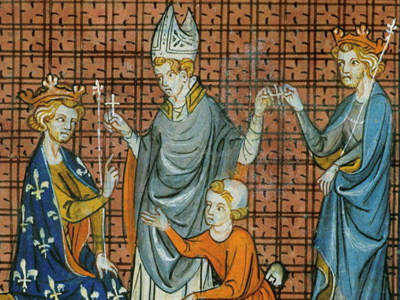
King Richard and King Philip's Departure
King Henry II of England died on 6 July 1189 after a surprise attack by his son Richard the Lionheart and King Philip II. Richard inherited the crown and immediately began raising funds for the crusade. In the meantime, some of his subjects departed in multiple waves by sea. Some of them together with contingents from the Holy Roman Empire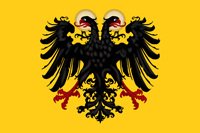 The Holy Roman Empire was a political entity in Western, Central, and Southern Europe that developed during the Early Middle Ages and continued until its dissolution in 1806 during the Napoleonic Wars. From the accession of Otto I in 962 until the twelfth century, the Empire was the most powerful monarchy in Europe. The empire reached the apex of territorial expansion and power in the mid-thirteenth century, but overextending led to partial collapse. and France
The Holy Roman Empire was a political entity in Western, Central, and Southern Europe that developed during the Early Middle Ages and continued until its dissolution in 1806 during the Napoleonic Wars. From the accession of Otto I in 962 until the twelfth century, the Empire was the most powerful monarchy in Europe. The empire reached the apex of territorial expansion and power in the mid-thirteenth century, but overextending led to partial collapse. and France The Kingdom of France is the historiographical name or umbrella term given to various political entities of France in the medieval and early modern period. It was one of the most powerful states in Europe since the High Middle Ages. It was also an early colonial power, with possessions around the world. Colonial conflicts with Great Britain led to the loss of much of its North American holdings by 1763. The Kingdom of France adopted a written constitution in 1791, but the Kingdom was abolished a year later and replaced with the First French Republic. conquered the Moorish city of Silves in Iberia during the summer of 1189, before continuing to the Holy Land. In April 1190, King Richard's fleet departed from Dartmouth under the command of Richard de Camville and Robert de Sablé on their way to meet their king in Marseille. Parts of this fleet helped the Portuguese monarch Sancho I defeat an Almohad counterattack against Santarém and Torres Novas, while another group ransacked Christian Lisbon, only to be routed by the Portuguese monarch. Richard and Philip II met in France at Vézelay and set out together on 4 July 1190 as far as Lyon where they parted after agreeing to meet in Sicily; Richard with his retinue, said to number 800, marched to Marseille and Philip to Genoa. Richard arrived in Marseille and found that his fleet had not arrived; he quickly tired of waiting for them and hiring ships, left for Sicily on 7 August, visiting several places in Italy en route and arrived in Messina on 23 September. Meanwhile, the English
The Kingdom of France is the historiographical name or umbrella term given to various political entities of France in the medieval and early modern period. It was one of the most powerful states in Europe since the High Middle Ages. It was also an early colonial power, with possessions around the world. Colonial conflicts with Great Britain led to the loss of much of its North American holdings by 1763. The Kingdom of France adopted a written constitution in 1791, but the Kingdom was abolished a year later and replaced with the First French Republic. conquered the Moorish city of Silves in Iberia during the summer of 1189, before continuing to the Holy Land. In April 1190, King Richard's fleet departed from Dartmouth under the command of Richard de Camville and Robert de Sablé on their way to meet their king in Marseille. Parts of this fleet helped the Portuguese monarch Sancho I defeat an Almohad counterattack against Santarém and Torres Novas, while another group ransacked Christian Lisbon, only to be routed by the Portuguese monarch. Richard and Philip II met in France at Vézelay and set out together on 4 July 1190 as far as Lyon where they parted after agreeing to meet in Sicily; Richard with his retinue, said to number 800, marched to Marseille and Philip to Genoa. Richard arrived in Marseille and found that his fleet had not arrived; he quickly tired of waiting for them and hiring ships, left for Sicily on 7 August, visiting several places in Italy en route and arrived in Messina on 23 September. Meanwhile, the English The Kingdom of England was a sovereign state on the island of Great Britain from about 927, when it emerged from various Anglo-Saxon kingdoms, until 1 May 1707, when it united with Scotland to form the Kingdom of Great Britain. The Viking invasions of the 9th century upset the balance of power between the English kingdoms, and native Anglo-Saxon life in general. The English lands were unified in the 10th century in a reconquest completed by King Æthelstan in 927. fleet eventually arrived in Marseille on 22 August, and finding that Richard had gone, sailed directly to Messina, arriving before him on 14 September. Philip had hired a Genoese fleet to transport his army, which consisted of 650 knights, 1,300 horses, and 1,300 squires to the Holy Land by way of Sicily.
The Kingdom of England was a sovereign state on the island of Great Britain from about 927, when it emerged from various Anglo-Saxon kingdoms, until 1 May 1707, when it united with Scotland to form the Kingdom of Great Britain. The Viking invasions of the 9th century upset the balance of power between the English kingdoms, and native Anglo-Saxon life in general. The English lands were unified in the 10th century in a reconquest completed by King Æthelstan in 927. fleet eventually arrived in Marseille on 22 August, and finding that Richard had gone, sailed directly to Messina, arriving before him on 14 September. Philip had hired a Genoese fleet to transport his army, which consisted of 650 knights, 1,300 horses, and 1,300 squires to the Holy Land by way of Sicily.
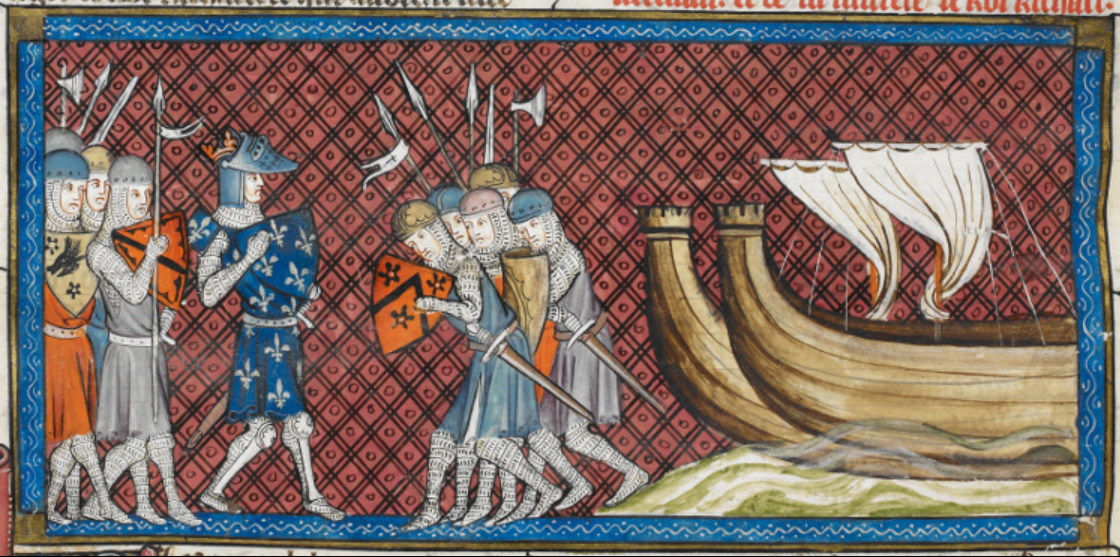
Philip II depicted arriving in Palestine
William II of Sicily had died the previous year, and was replaced by Tancred, who imprisoned Joan of England—William's wife and King Richard's sister. Richard captured the city of Messina on 4 October 1190 and Joan was released. Richard and Philip fell out over the issue of Richard's marriage, as Richard had decided to marry Berengaria of Navarre, breaking off his long-standing betrothal to Philip's half-sister Alys. Philip left Sicily directly for the Middle East on 30 March 1191 and arrived in Tyre in mid-May; he joined the siege of Acre on 20 May. Richard did not set off from Sicily until 10 April.
Shortly after setting sail from Sicily, King Richard's armada of 180 ships and 39 galleys was struck by a violent storm. Several ships ran aground, including one holding Joan, his new fiancée Berengaria and a large amount of treasure that had been amassed for the crusade. It was soon discovered that Isaac Dukas Comnenus of Cyprus had seized the treasure. The young women were unharmed. Richard entered Limassol on 6 May and met with Isaac, who agreed to return Richard's belongings and to send 500 of his soldiers to the Holy Land. Richard made camp at Limassol, where he received a visit from Guy of Lusignan, the King of Jerusalem, and married Berengaria, who was crowned queen. Once back at his fortress of Famagusta, Isaac broke his oath of hospitality and began issuing orders for Richard to leave the island. Isaac's arrogance prompted Richard to conquer the island within days, finally leaving on 5 June 1191.
HISTORY
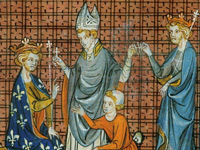
RESOURCES
This article uses material from the Wikipedia article "Third Crusade (1189–1192)", which is released under the Creative Commons Attribution-Share-Alike License 3.0.
© Stories Preschool. All Rights Reserved.
